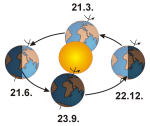 Seasons
Seasons
Due to the inclination of the terrestrial axis referring to the axis of the revolution around the sun, northern and southern hemisphere receive variable amounts of sunlight in the course of a revolution.
At the dates of equinox (21. of march and 23. of september), northern and southern hemispere receive the same amount of light. From march to september, the northern hemisphere receives more light, from september to march the southern hemisphere. Accordingly, northern winters refer to southern summers and northern summers to southern winters. The differences in sunlight radiation and the respective seasons are increasing in importance when moving from the equator to the poles (i.e. from the tropics passing the subtropics, the temperate zone up to the polar zone).